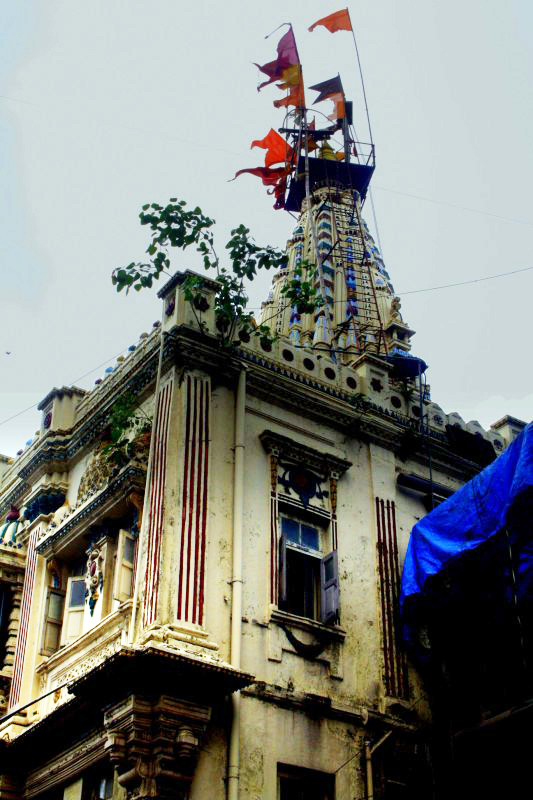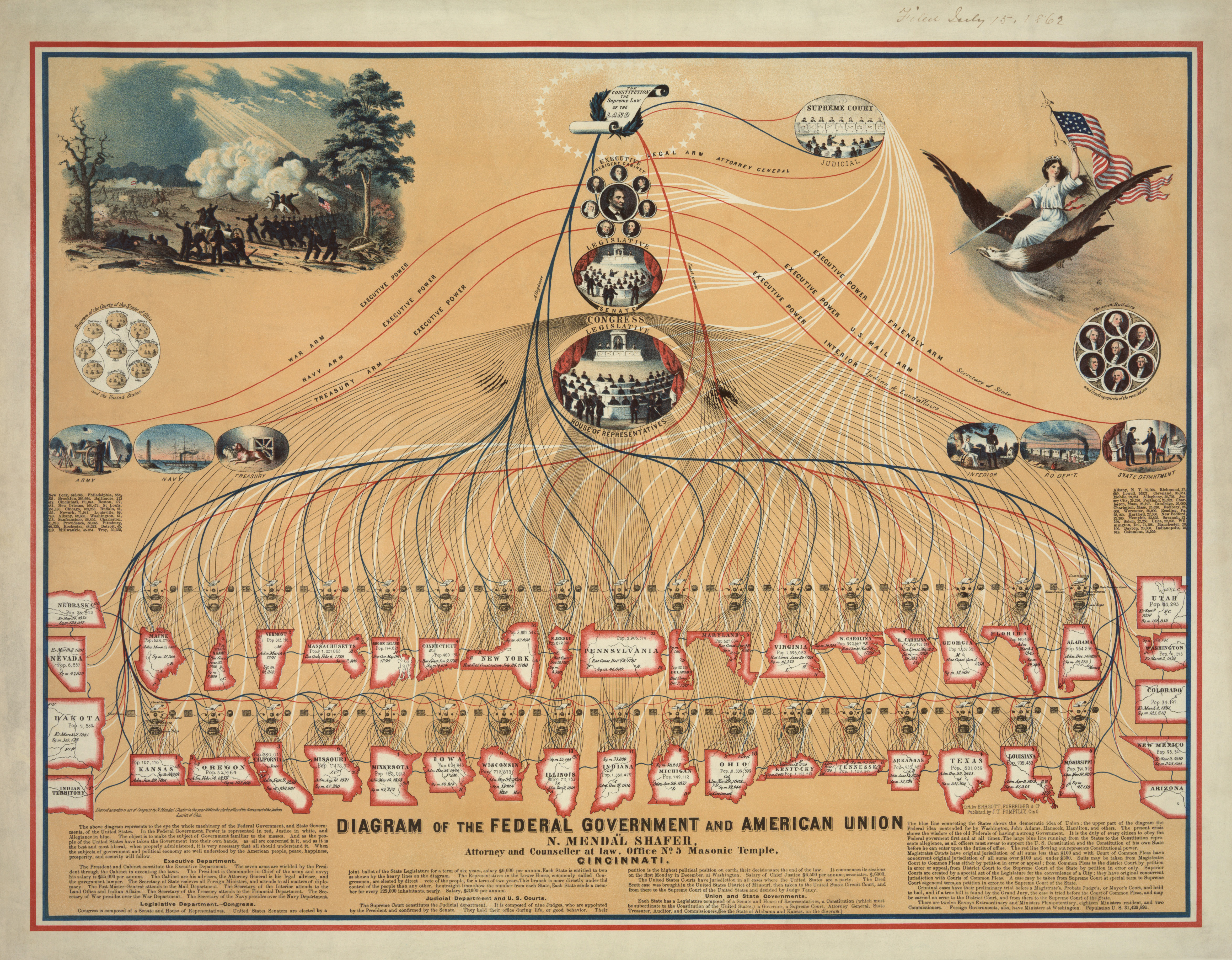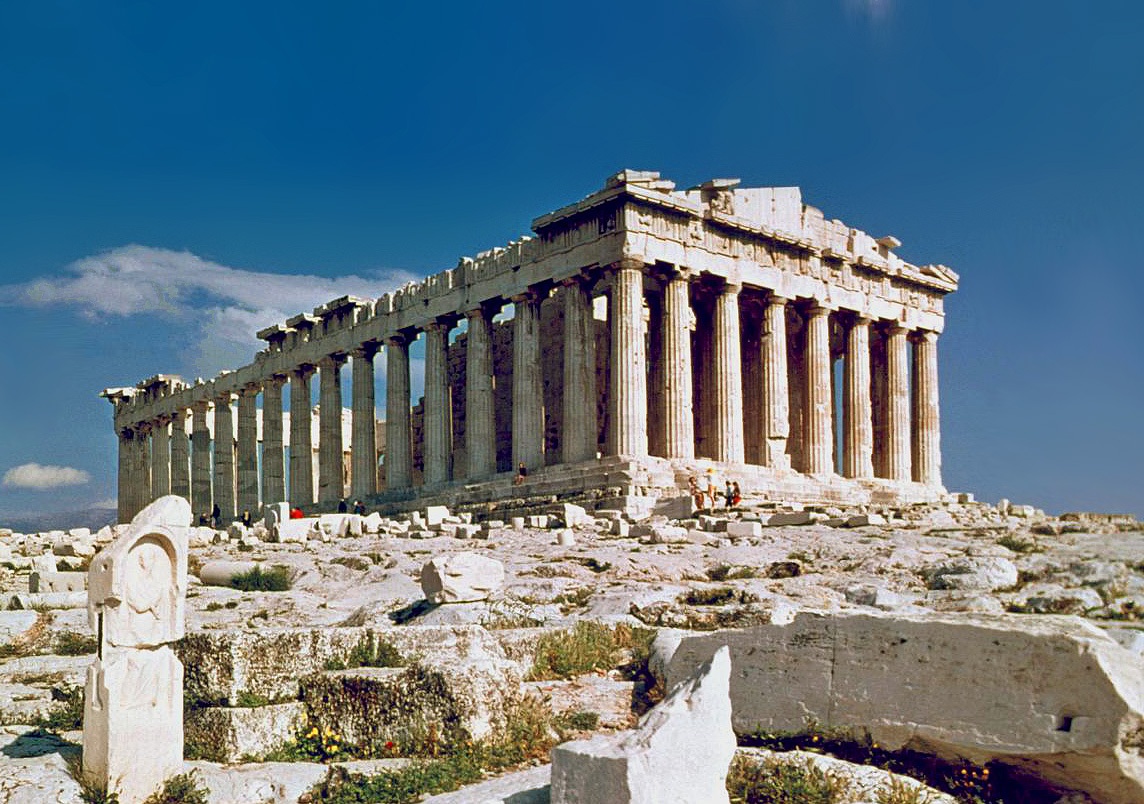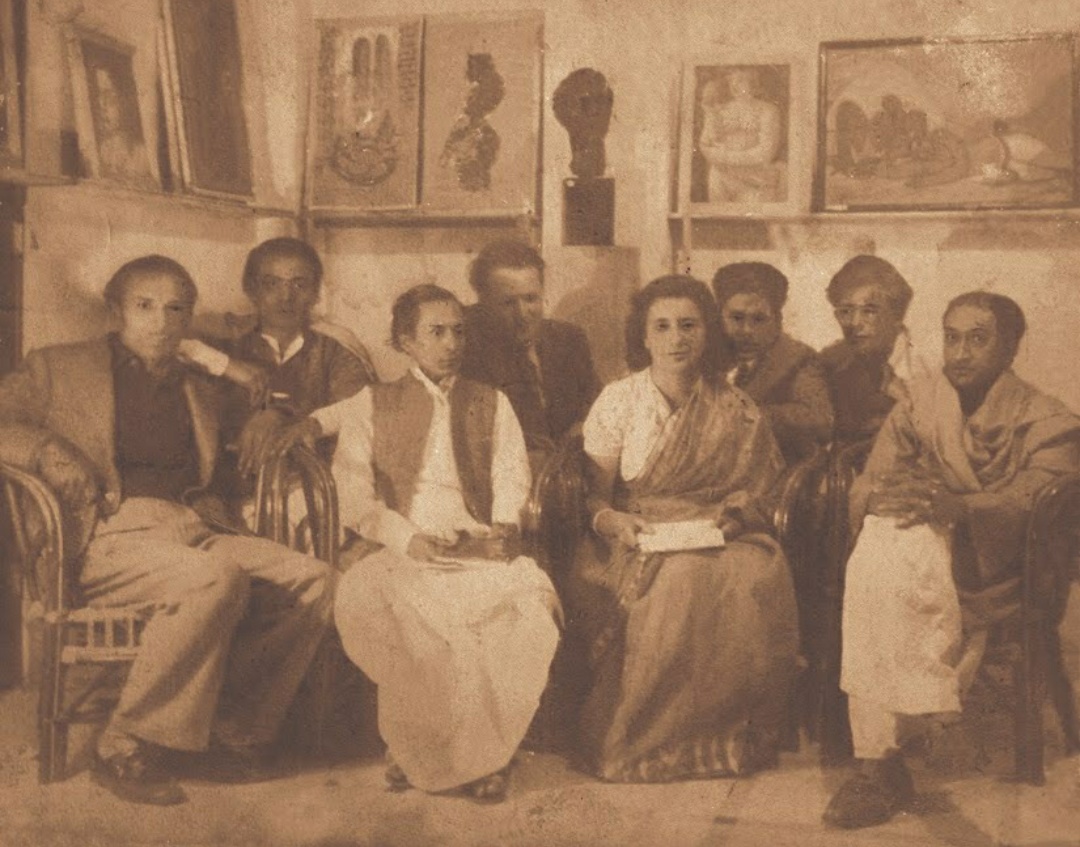|
Bombay Progressive Artists' Group
The Progressive Artists' Group (PAG), was a group of modern artists, mainly based in Bombay, from its formation in 1947. Though it lacked any particular style, there might be said to have been a move towards a synthesis of influences from Indian art history together with styles prevalent in Europe and North America during the first half of the 20th century, including Post-Impressionism, Cubism and Expressionism. History The Progressive Artists' Group (PAG) was formed by six founder members, F. N. Souza, S. H. Raza, M. F. Husain, K. H. Ara, H. A. Gade, and S. K. Bakre (the only sculptor in the group). Others, who later got associated with the group included Ram Kumar, Akbar Padamsee and Tyeb Mehta. The group wished to break with the revivalist nationalism established by the Bengal school of art and to encourage an Indian avant-garde, engaged at an international level. The Group was formed just months after the 14 August 1947 "Partition of India" and Pakistan that resu ... [...More Info...] [...Related Items...] OR: [Wikipedia] [Google] [Baidu] |
Bombay Progressive Artists Group
Mumbai ( ; ), also known as Bombay ( ; its official name until 1995), is the capital city of the Indian state of Maharashtra. Mumbai is the financial capital and the most populous city proper of India with an estimated population of 12.5 million (1.25 crore). Mumbai is the centre of the Mumbai Metropolitan Region, the seventh-most populous metropolitan area in the world with a population of over 23 million (2.3 crore). Mumbai lies on the Konkan coast on the west coast of India and has a deep natural harbour. In 2008, Mumbai was named an alpha world city. Mumbai has the highest number of billionaires out of any city in Asia. The seven islands that constitute Mumbai were earlier home to communities of Marathi language-speaking Koli people. For centuries, the seven islands of Bombay were under the control of successive indigenous rulers before being ceded to the Portuguese Empire, and subsequently to the East India Company in 1661, as part of the dowry of C ... [...More Info...] [...Related Items...] OR: [Wikipedia] [Google] [Baidu] |
Bombay
Mumbai ( ; ), also known as Bombay ( ; its official name until 1995), is the capital city of the Indian States and union territories of India, state of Maharashtra. Mumbai is the financial centre, financial capital and the list of cities in India by population, most populous city proper of India with an estimated population of 12.5 million (1.25 crore). Mumbai is the centre of the Mumbai Metropolitan Region, the List of largest cities, seventh-most populous metropolitan area in the world with a population of over 23 million (2.3 crore). Mumbai lies on the Konkan coast on the west coast of India and has a deep natural harbour. In 2008, Mumbai was named an Globalization and World Cities Research Network#Alpha, alpha world city. Mumbai has the List of cities by number of billionaires, highest number of billionaires out of any city in Asia. The seven islands that constitute Mumbai were earlier home to communities of Marathi language-speaking Koli people. For cent ... [...More Info...] [...Related Items...] OR: [Wikipedia] [Google] [Baidu] |
Organisations Based In Mumbai
An organization or organisation ( Commonwealth English; see spelling differences) is an entity—such as a company, or corporation or an institution ( formal organization), or an association—comprising one or more people and having a particular purpose. Organizations may also operate secretly or illegally in the case of secret societies, criminal organizations, and resistance movements. And in some cases may have obstacles from other organizations (e.g.: MLK's organization). What makes an organization recognized by the government is either filling out incorporation or recognition in the form of either societal pressure (e.g.: Advocacy group), causing concerns (e.g.: Resistance movement) or being considered the spokesperson of a group of people subject to negotiation (e.g.: the Polisario Front being recognized as the sole representative of the Sahrawi people and forming a partially recognized state.) Compare the concept of social groups, which may include non-or ... [...More Info...] [...Related Items...] OR: [Wikipedia] [Google] [Baidu] |
Modern Art
Modern art includes artistic work produced during the period extending roughly from the 1860s to the 1970s, and denotes the styles and philosophies of the art produced during that era. The term is usually associated with art in which the traditions of the past have been thrown aside in a spirit of experimentation. Modern artists experimented with new ways of seeing and with fresh ideas about the nature of materials and functions of art. A tendency away from the narrative, which was characteristic of the traditional arts, toward abstraction is characteristic of much modern art. More recent artistic production is often called contemporary art or Postmodern art. Modern art begins with the post-impressionist painters like Vincent van Gogh, Paul Cézanne, Paul Gauguin, Georges Seurat and Henri de Toulouse-Lautrec. These artists were essential to modern art's development. At the beginning of the 20th century Henri Matisse and several other young artists including the Proto-Cubism, pre ... [...More Info...] [...Related Items...] OR: [Wikipedia] [Google] [Baidu] |
Organizations Disestablished In 1956
An organization or organisation ( Commonwealth English; see spelling differences) is an entity—such as a company, or corporation or an institution (formal organization), or an association—comprising one or more people and having a particular purpose. Organizations may also operate secretly or illegally in the case of secret societies, criminal organizations, and resistance movements. And in some cases may have obstacles from other organizations (e.g.: MLK's organization). What makes an organization recognized by the government is either filling out incorporation or recognition in the form of either societal pressure (e.g.: Advocacy group), causing concerns (e.g.: Resistance movement) or being considered the spokesperson of a group of people subject to negotiation (e.g.: the Polisario Front being recognized as the sole representative of the Sahrawi people and forming a partially recognized state.) Compare the concept of social groups, which may include non-org ... [...More Info...] [...Related Items...] OR: [Wikipedia] [Google] [Baidu] |
Arts Organizations Established In 1947
The arts or creative arts are a vast range of human practices involving creative expression, storytelling, and cultural participation. The arts encompass diverse and plural modes of thought, deeds, and existence in an extensive range of media. Both a dynamic and characteristically constant feature of human life, the arts have developed into increasingly stylized and intricate forms. This is achieved through sustained and deliberate study, training, or theorizing within a particular tradition, generations, and even between civilizations. The arts are a medium through which humans cultivate distinct social, cultural, and individual identities while transmitting values, impressions, judgments, ideas, visions, spiritual meanings, patterns of life, and experiences across time and space. The arts are divided into three main branches. Examples of visual arts include architecture, ceramic art, drawing, filmmaking, painting, photography, and sculpture. Examples of literature include ... [...More Info...] [...Related Items...] OR: [Wikipedia] [Google] [Baidu] |
Art Movements
An art movement is a tendency or style in art with a specific art philosophy or goal, followed by a group of artists during a specific period of time, (usually a few months, years or decades) or, at least, with the heyday of the movement defined within a number of years. Art movements were especially important in modern art, when each consecutive movement was considered a new avant-garde movement. Western art had been, from the Renaissance up to the middle of the 19th century, underpinned by the logic of Perspective (graphical), perspective and an attempt to reproduce an illusion of visible reality (figurative art). By the end of the 19th century many artists felt a need to create a new Style (visual arts), style which would encompass the fundamental changes taking place in technology, science and philosophy (abstract art). Concept According to theories associated with modernism and also the concept of Postmodern art, postmodernism, ''art movements'' are especially important dur ... [...More Info...] [...Related Items...] OR: [Wikipedia] [Google] [Baidu] |
Arts Organisations Based In India
The arts or creative arts are a vast range of human practices involving creative expression, storytelling, and cultural participation. The arts encompass diverse and plural modes of thought, deeds, and existence in an extensive range of media. Both a dynamic and characteristically constant feature of human life, the arts have developed into increasingly stylized and intricate forms. This is achieved through sustained and deliberate study, training, or theorizing within a particular tradition, generations, and even between civilizations. The arts are a medium through which humans cultivate distinct social, cultural, and individual identities while transmitting values, impressions, judgments, ideas, visions, spiritual meanings, patterns of life, and experiences across time and space. The arts are divided into three main branches. Examples of visual arts include architecture, ceramic art, drawing, filmmaking, painting, photography, and sculpture. Examples of literature include ... [...More Info...] [...Related Items...] OR: [Wikipedia] [Google] [Baidu] |
Partition Of India
The partition of India in 1947 was the division of British India into two independent dominion states, the Dominion of India, Union of India and Dominion of Pakistan. The Union of India is today the Republic of India, and the Dominion of Pakistan is the Islamic Republic of Pakistan and the People's Republic of Bangladesh. The Partition (politics), partition involved the division of two provinces, Bengal and the Punjab Province (British India), Punjab, based on district-wise Hindu or Muslim majorities. It also involved the division of the British Indian Army, the Royal Indian Navy, the Indian Civil Service, the History of rail transport in India, railways, and the central treasury, between the two new dominions. The partition was set forth in the Indian Independence Act 1947 and resulted in the dissolution of the British Raj, or Crown rule in India. The two self-governing countries of India and Pakistan legally came into existence at midnight on 14–15 August 1947. The partiti ... [...More Info...] [...Related Items...] OR: [Wikipedia] [Google] [Baidu] |
Calcutta Group
The Calcutta Group was a group of modern artists in India, formed in 1943 in Kolkata Kolkata, also known as Calcutta ( its official name until 2001), is the capital and largest city of the Indian state of West Bengal. It lies on the eastern bank of the Hooghly River, west of the border with Bangladesh. It is the primary .... It has the distinction of being the first artistic movement of its kind in both Bengal and all of India. Though short-lived – the group disbanded in 1953 – the Calcutta Group was instrumental in the transformation of contemporary Indian art and brought this genre onto the world stage. Members Core members (1943) * Subho Tagore * Nirode Mazumdar * Rathin Maitra * Prankrishna Pal * Gopal Ghosh * Paritosh Sen * Prodosh Dasgupta * Kamala Das Gupta Additional members * Abani Sen (1947) * Rathin Mitra (1949) * Gobardhan Ash (1950) * Sunil Madhav Sen (1952) * Hemant Misra (1950) Formation Rathin Maitra and Subho Tagore ... [...More Info...] [...Related Items...] OR: [Wikipedia] [Google] [Baidu] |
Baroda Group
The Baroda Group refers to the artists involved with the Faculty of Fine Arts at Maharaja Sayajirao University of Baroda, now known as Vadodara in Gujarat state of India. An experimental art school that drew artists of a variety of backgrounds, the Baroda Group offered an alternative to the nationalism associated with Santiniketan and the Bengal School. The dynamic group was formed in 1957 under the guidance of N. S. Bendre. Prominent artists associated with the group were N. S. Bendre, Bhupen Khakhar, Gulam Mohammed Sheikh, Ratan Parimoo, Rekha Rodwittiya, Jyotsna Bhatt, Vivan Sundaram, K. G. Subramanyan, Jayant Parikh and Jeram Patel. History The Faculty of Fine Arts, established in 1949, at Maharaja Sayajirao University of Baroda was intended to provide an alternative to established art schools while promoting the value of contemporary art. The school's curriculum centered around the concept of "Living Traditions," or the idea that traditions are necessary to modern and co ... [...More Info...] [...Related Items...] OR: [Wikipedia] [Google] [Baidu] |
Hammer Price
In auctions, the buyer's premium is a charge in addition to the hammer price (i.e. the winning bid announced) of an auction item, or lot. The winning bidder is required to pay both the hammer price and the percentage of that price called for by the buyer's premium. It is charged by the auctioneer in addition to the commission which has always been charged by auction houses to sellers. All of the buyer's premium is retained by the auction house and is not shared with the item's seller. Major auction houses have levied the buyer's premium for several decades, particularly in fine art auctions, with percentages in the region of 10–30%. In real estate auctions in many European countries, the buyer's premium, if charged at all, is much less (2–2.5%). More recently in the UK, however, repossessed properties have been offered without fee to the seller, but with a buyer's premium of 10%. The buyer's premium has been characterized by auction houses as a necessary contribution to the ... [...More Info...] [...Related Items...] OR: [Wikipedia] [Google] [Baidu] |







